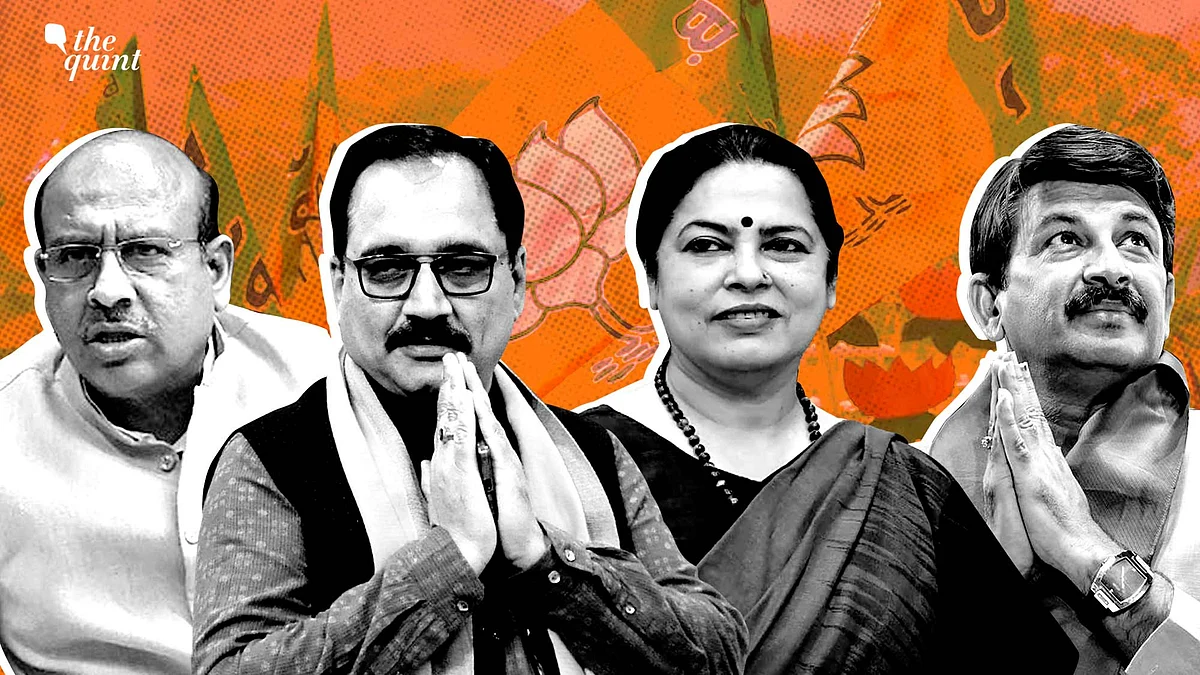
Delhi Elections: 5 Reasons Why BJP isn't Declaring a CM Candidate
BJP has struggled to put up a face in Delhi to counter first Sheila Dikshit and now Arvind Kejriwal.

advertisement
The BJP seems all set to fight the Delhi Assembly elections without a chief ministerial candidate. The Aam Aadmi Party has been taunting the BJP on this issue, calling it a 'Baraat without a groom'. AAP convenor and former CM Arvind Kejriwal also said that the BJP's CM face is Ramesh Bidhuri, a politician who is known to make controversial statements and recently made misogynist remarks about CM Atishi Singh and Congress leader Priyanka Gandhi.
Despite AAP's attacks, the BJP so far hasn't taken the bait and it has desisted from projecting a CM face. This may be a sensible strategy on the party of the BJP. Here's why.
It Doesn't Have a Leader With Pan-Delhi Popularity
The party doesn't have a clear face in Delhi. In fact, it hasn't had such a face for a very long time, since the sidelining of Madan Lal Khurana over 25 years ago. After Khurana, the BJP has formally or informally projected a number of faces in Delhi - such as Sahib Singh Verma, Sushma Swaraj, Vijay Kumar Malhotra, Dr Harsh Vardhan, Kiran Bedi and Manoj Tiwari. But none of them could defeat the two figures who have dominated Delhi's politics - Sheila Dikshit from 1998 to 2013 and Kejriwal from 2013 till now.
Projecting a CM Face Could Make it a Personality Contest
It's not as if BJP doesn't have leaders in Delhi - Vijender Gupta for instance won Rohini even amid AAP's landslide wins in 2015 and 2020. Then there are former MPs like Meenakshi Lekhi and Parvesh Verma who retain some influence.
However, projecting anyone could make the election a personality contest with Kejriwal. This hasn't worked well for the party. In 2015, it projected Kejriwal's Anna Hazare-agitation comrade, Kiran Bedi, and it proved to be a colossal disaster for the BJP. The party was reduced to just 3 seats and Bedi herself lost from Krishna Nagar, considered one of the safest seats for BJP.
It didn't project anyone in 2020 but the then state BJP chief, actor Manoj Tiwari, was seen as the party's de-facto face and that didn't help the party either.
For example in the 2020 elections, nearly 50 percent people surveyed by CSDS in Delhi said that they want Kejriwal to be the CM and the next most popular leader was Manoj Tiwari at around 6 percent.
There's another aspect to this. The BJP believes that a personality centric approach will divert attention from the issues it seeks to raise in the election.
Anti-Incumbency the Main Narrative
The main narrative of BJP's campaign is what it calls the failures of 10 years of AAP rule. It has targeted AAP on a number of governance related issues such as roads, pollution, waste management, power supply etc.
Two things are helping the BJP's narrative. First, is the fact that AAP and Kejriwal are no longer the 'outsiders' in politics, having now been in power for ten years.
Second, for the first time, AAP now helms both the Delhi government and the Municipal Corporation of Delhi. Earlier, AAP would escape blame on issues like waste management because they would fall under the domain of the MCD, then controlled by the BJP.
Had BJP projected a CM face, the campaign may have become less centered on issues and more on personality.
Different Leaders, Different Communities
BJP's main problem in Delhi is that it had alienated a number of key demographic groups such as Dalits, Sikhs and Purvanchalis. Read this piece by senior journalist Manish Anand to know more. By fielding a number of prominent leaders, the BJP is trying to cater to different demographic groups. Some of these leaders include Vijender Gupta (Baniya), Dushyant Kumar Gautam (Dalit), Parvesh Verma (Jat), Ramesh Bidhuri (Gujjar), Kapil Mishra (Brahmin, also being used to woo Purvanchalis), Mohan Singh Bisht (Pahari), Harish Khurana (Punjabi Hindu), Manjinder Sirsa and Arvinder Singh Lovely (Sikh).
PM Modi as the Main Face
There's no doubt that PM Modi enjoys considerable popularity in Delhi. BJP has now swept all seven Lok Sabha seats in Delhi thrice in a row.
The problem for the BJP has been that the PM's popularity hasn't been a voting issue at the Assembly level, which have been centered around the personality of Kejriwal.
In this election, BJP hopes that 10 years of anti-incumbency and Kejriwal being replaced by Atishi as CM, may make the voters support the BJP for the sake of "stability" and "better coordination between Centre and state".
Whether this narrative works or not, remains to be seen. A lot would depend on how successful the BJP is in weaning away poorer and lower middle class voters from AAP.
- Access to all paywalled content on site
- Ad-free experience across The Quint
- Early previews of our Special Projects
Published: undefined